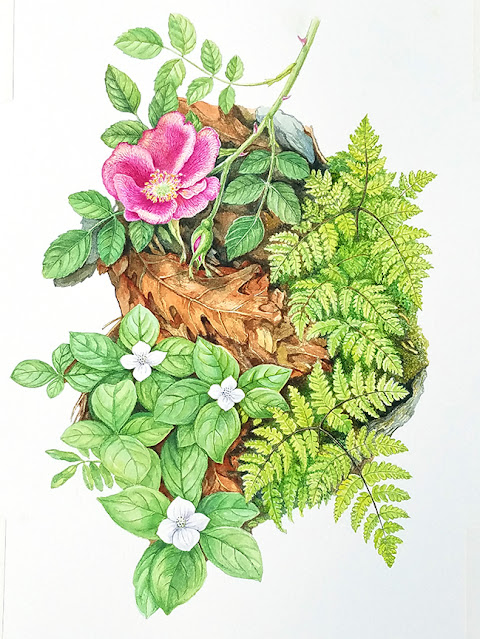 |
| Cardinal Flower (Lobelia cardinalis) in miy front yard. |
Tropical storm Debby arrived in our area last Wednesday evening and stayed through Friday. During that time Debby brought us a generous 6.75 inches of rain--a real gift! After such a severe drought during June and July, my garden is now reviving after these rains. Unfortunately, the deer have eaten so much, there aren't a lot of flowers left, but here are some of what is left for August's Bloom Day.
The cardinal flower (Lobelia cardinalis) under the cherry tree in front has come back--the one I'd planted in a back bed last year died in July--too dry a site for it, I expect. The location of this other seems to suit it, I hope I can get more plants to grow here.
 |
| Wild Ageratum on the east bed. |
The wild Ageratum (Conoclinium coelestinum) which continues to reseed itself in the east bed and Herb's bed was looking very droopy, but it perked up a lot with the rains. Unfortunately the deer have eaten all of my Blue Lobelias (Lobelia siphyllitica) in the same bed, and their usual masses of flowers are gone.
 |
| Red Salvia |
The red Salvia in Herb's bed is offering its blooms for the hummingbirds--we finally spotted a few recently, after seeing none in June and July. The deer ate the blue Agapanthus earlier, but another flowering spike has appeared; they didn't get this one after I sprayed it with repellent!
 |
| Agapanthus 'Blue Nile' |
Deer generally avoid Agastaches, so my 'Blue Boa' were not touched, but the drought set it back somewhat. I need a few more plants to make this patch show up--another project for the fall or next spring!
 |
| Agastache 'Blue Boa' |
 |
| Black-eyed Susans (Rudbeckia 'Goldsturm') |
A few black-eyed Susans bloomed after the rains despite the deer eating back most of the buds, ditto for the Coneflowers in the back bed. The Seven Son Flower tree is starting to bloom too.
 |
| Purple Coneflowers reblooming. |
 |
| Seven Son Flower tree (Heptacodium miconoides) |
A few other blooms typical for this time of the year: white 'Natchez' crapemyrtle, and Russian sage (Perovskia).
 |
| Crape myrtle 'Natchez' with Abelia 'Panoramic' and Japanese maple. |
 |
| Russian sage (Perovskia atriplicifolia) |
Most of my potted plants had to be moved to the porch or the back deck to be safe from the deer--they were bold enough to nibble the black cotton plants I had in pots on the front steps of the house! They ate back the 'Black and Blue' Brazilian Salvia too, which is only now starting to put out a few budding spikes.
 |
| Irish moss (Sagina subulata) |
This Irish moss plant has survived for several years in a pot that used to hold a blueberry plant, 'Top Hat'. The blueberry died out this summer, but the Irish moss has persisted. My hanging baskets on the porch haven't filled out as I hoped, but they are colorful. The problem with these Pamela Crawford side planters is they use up so much water! They dry out quickly too, and a few plants never make it, leaving large areas of the coir baskets exposed--not very attractive.
 |
| Porch baskets. |
 |
| Front porch basket |
 |
| Potted plants on the deck. |
 |
| Tuberous begonia on deck. |
We'll finish up with my two recent watercolors: Ice Mountain Suite #1 has been accepted into Art at the Mill's fall 2024 show. I'm working on completing Ice Mountain suite #2
 | |||
| Ice Mountain Suite #1, watercolor. |
 |
| Ice Mountain Suite #2. |
Bloom Day on the 15 on every month is brought to you by to Carol Michel's May Dreams Garden blog, Happy August Bloom Day!


















